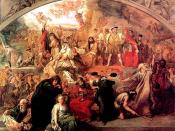Love, Not Life, Lasts Forever In William Shakespeare?s Sonnet "73," the speaker invokes a series of metaphors to characterize the nature of his old age. The structure of the sonnet also contributes to the meaning of the poem. In the first quatrain, there is the final season of a year; then, in the second quatrain, only the final hours of a day; and then, in the third quatrain, the final minutes of a fire, before the couplet resolves the argument. The metaphors begin in the first quatrain and continue throughout the sonnet, as one by one they are destroyed, just like the life that is being spoken about. This poem is not simply a procession of interchangeable metaphors; it is the story of the speaker slowly realizing the finality of his life and his impermanence in time. Through the use of the structure of "Sonnet 73" and the metaphors that describe the speaker?s death, Shakespeare conveys that while life may be short, if one can love during that lifetime, that love can live forever.
In the first quatrain, the speaker tells his beloved that his age is like a "time of year," by employing the metaphor of late autumn, which emphasizes the harshness and emptiness of old age. The speaker continues this feeling of old age with the metaphors, "when yellow leaves, or none, or few, do hang upon the boughs which shake against the cold" (lines 2-3). Those metaphors clearly indicate that winter, which usually symbolizes loneliness and desolation, is coming. The leaves that are falling off the branches symbolize the old man?s loss of hair, and the boughs shaking against the cold symbolize the frailty of his limbs, both of which are signs of old age and nearing death. The speaker also uses a metaphor...


